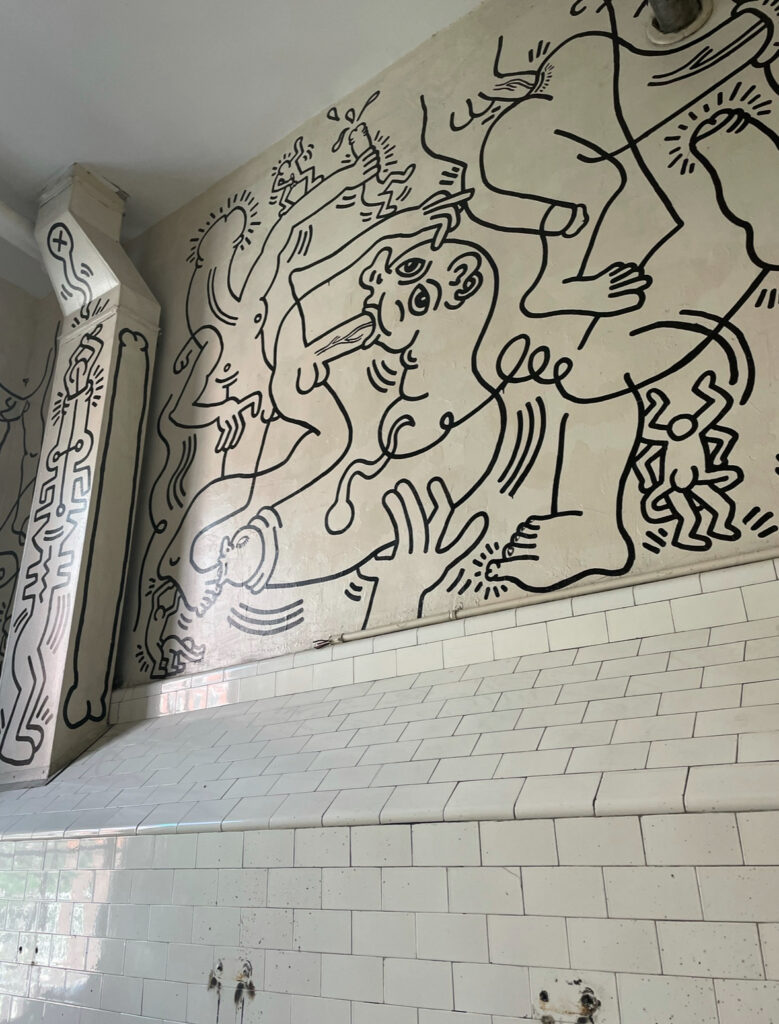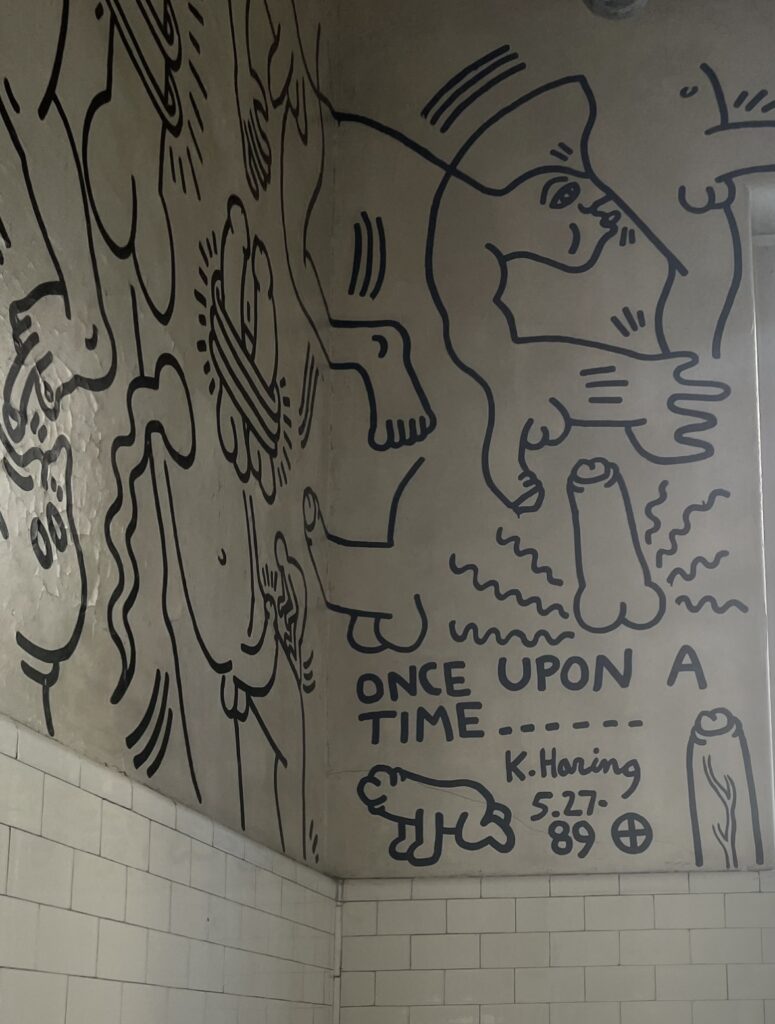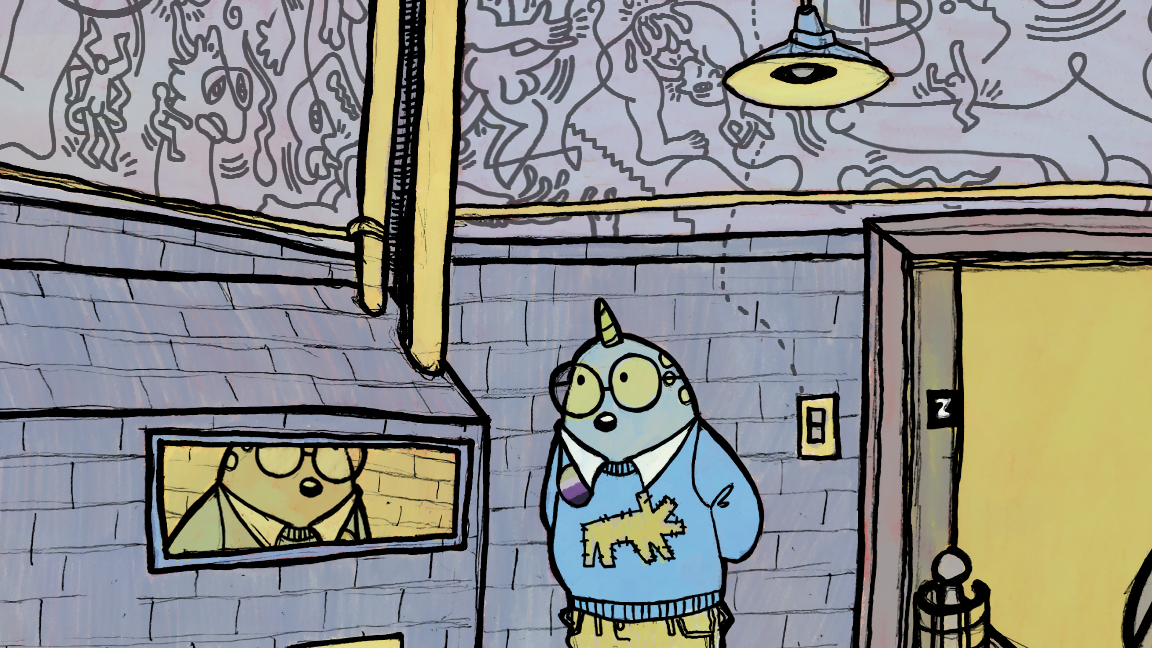The New Review is a biweekly series where writer Kayley Cassidy will examine an art installation or exhibition close to The New School campus. This week, she spent time partying with the funky doodles of Keith Haring in his bathroom mural “Once Upon A Time.”
As New School students, I’m sure you all anticipate the much-needed spring break just around the corner. So close (yet so far), but who’s to say there can’t be a little bit of a celebration in the meantime? Whether you’re going on vacation or staying in the city over the break — before you leave campus this week, live it up with our neighbors at The Lesbian, Gay, Bisexual & Transgender Community Center.
By “live it up,” I mean go to their bathroom. A three minute walk west from the Mannes School of Music will take you to The Center. Upon entry, you’ll ascend the spiral staircase to the second floor. Make your way to the room directly across from the stairs, and you’ll realize this is NOT one of Manhattan’s few public toilets. Instead of relieving yourself, you’ll be reliving the past. Peer through the thin glass strip of the door that separates you and the bathroom, and notice the playful figures dancing among one another in Keith Haring’s “Once Upon A Time.”
The party has just begun as you immerse yourself in the mural of signature squiggly, groovy doodles that cover the four interior walls. Allow yourself to walk around the small space that reflects the remnants of what used to be, where markings along the tiled floor signify a time where toilets and stalls once stood.
Look in the mirror above the sign that says, “Wash your hands before leaving this room,” and travel back in time to the late 1970s and early 1980s. Feel the upbeat thumping of drums from the “Love Boat” theme song that played weekly at Club 57, where Haring and other young art prodigies created their own personal clubhouse. Jolt to “Rock Lobster” by the B-52’s, and smell the fresh poignant sting of graffiti paint on vacant walls. Wrestle with the art world of downtown Manhattan at its peak, and let the heat of it make you sweat.
“Once Upon A Time” was created in May 1989 at The Center in celebration of the 20th anniversary of the Stonewall Riots. The Center states the mural “celebrates sexual liberation in the days before the AIDS epidemic.” Minimalist black line drawings of intimate figures, liquids, babies, and phallic figures bounce along the white walls, entangling one another and connecting in some way. The sexual squiggles are exciting, paying homage to a time when bathrooms became a queer space of sexual endeavors.

Haring has always been a symbol of the city. Not only is he an artist but an activist too. His doodles tackle safe sex, AIDS awareness, sexuality, identity, love, and more social issues from the 1980s that continue to transcend time. His graffiti-like line drawings traveled from subway stations to public parks. Today his work has been commodified, taking form in expensive Urban Outfitters sweatshirts to overpriced furniture in the MoMA design store.
But instead of wasting $135 on a basketball that consists of Haring’s doodles, go look at one of his murals for free any day of the week. The site-specific artwork is a living descendant of Haring, continuing his tradition of transforming an exclusive art world by making it accessible to everyone.
In a CBS profile on Haring aired in 1982, he says, “You don’t have to know anything about art to appreciate it. There aren’t any hidden secrets or things that you’re supposed to understand.” Whether you understand these wacky homoerotic symbols or not, you can feel the passion reflected in the walls, particularly next to his signed name. You can almost hear him shuffling around the bathroom, the bristles of his brush lightly scraping against the walls.

The room symbolizes a life just days before the HIV/AIDS epidemic impacted the LGBTQ+ community. If you’re lucky and get the space to yourself when you visit The Center, I challenge you to embrace the silence. The silence in this room reflects the calm before a much louder and violent storm that would change this community forever, including a 31-year-old Haring, who died of AIDS nine months after the mural was created.
While the doodles are true to Haring’s style, they’re far different from his other works. The erotic, raw, evocative imagery makes this mural his most personal. It’s an act of defiance to queer people being silenced, where the shapes and morphing of figures are an outcry of queer love and identity.
The harsh black lines can be interpreted as sad compared to his other neon-colored works, but they’re still playful. At the time he created the mural, Haring was at the height of his career, living his life as a young artist in New York City. The future was uncertain, but the celebration in that bathroom, in that moment, was all that mattered.
There’s something we can all learn from these promiscuous doodles. Examine the lines and have your eyes travel with them across the four walls. Look into the eyes of the figures and try to mimic their animated poses. Permit the lines that blurred public and private, lust and love, to teach you a lesson about how bathrooms offered a sense of freedom to queer people. Think about what a secluded and private space can offer you.
Thank your body. Nurture it, take care of it and those you share it with. Remember the private spaces you have where you can celebrate lust and love, and recognize most people who sought this bathroom didn’t have that. Most importantly, appreciate your life. Live free in the moment like the beautiful people who made lower Manhattan the place you sought to immerse yourself in.
Walk toward the only window and look out on the street. Reflect on Haring’s art and his legacy instilled in and around campus. Picture the people in your life, your mind, and the senses you’ve used to get through the semester so far. Spring break gives us the time to rest. But in this bathroom, you can party forever.







